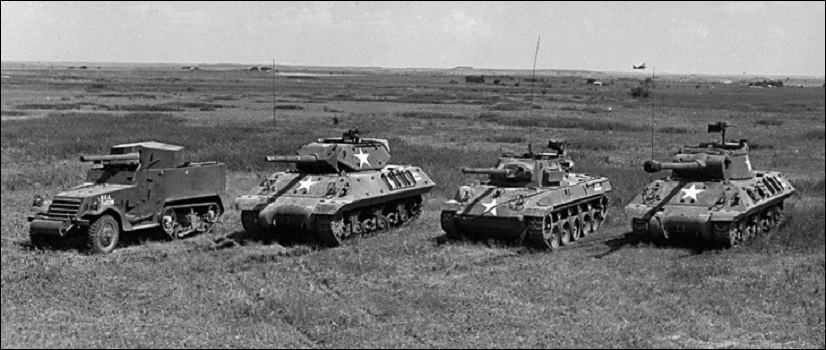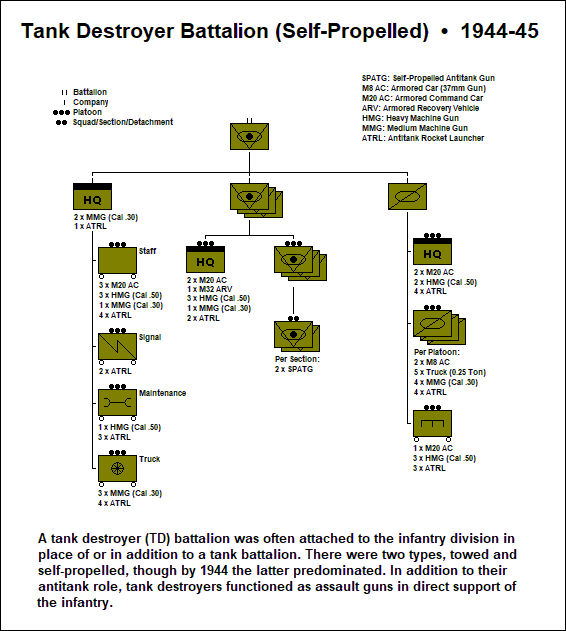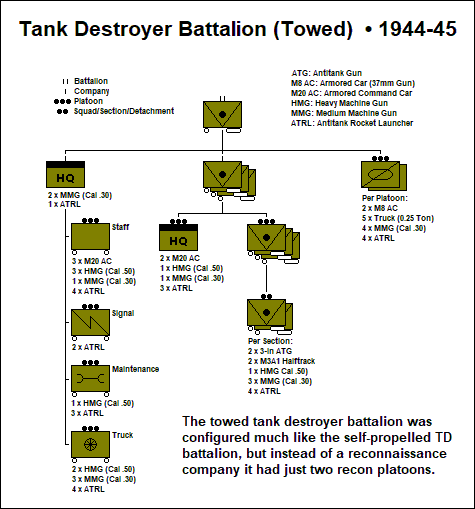The World War II US Army was
unusual in establishing a separate branch embodying antitank
units and personnel. The startling success of the German
Army’s Panzerwaffe in Poland and France focused the
Army leadership’s attention on the importance of antitank
defense. To the new triangular
infantry division, therefore,
an infantry antitank (AT) battalion was added. Additionally,
the division’s three infantry regiments each received a
separate AT company, for a divisional total of 72 x 37mm
antitank guns (ATG). The guns and personnel were drawn from
the Field Artillery branch, which thereby lost control of
antitank gunnery. But as things turned out only two
divisions actually received this battalion, for as they were
being set up the Army’s thinking on AT defense continued to
evolve.
Lieutenant General Leslie McNair,
the Chief of Staff, General Headquarters (GHQ), US Army,
believed that it was wasteful for tanks to oppose tanks on
defense when a much cheaper ATG could do the job. But even
so it seemed obvious that a unit with more firepower and
mobility than the infantry AT battalion would be required.
Thus was born the concept of the tank destroyer (TD)
battalion: a self-contained nondivisional antitank unit
capable of conducting a mobile defense against attacking
enemy armor.
On 27 November 1941 the War
Department ordered the activation of 53 TD battalions under
the direct control of GHQ. The two existing infantry AT
battalions were transferred from their parent divisions and
reorganized accordingly. Also ordered was the
establishment of a Tank Destroyer Tactical and Firing Center
at Fort Meade, Maryland. The Center was made responsible for
TD doctrine, equipment and training. Soon thereafter the
Tank Destroyer Force (TDF) became a separate Army branch.

Distinguishing Flag, 1st
Tank Destroyer Group
Two fundamental questions
confronted the new TDF: How were TD battalions to be
organized and equipped, and how were they to be employed?
The first question was quickly resolved thanks to the
existence of the 93rd AT Battalion, an experimental
nondivisional unit that had successfully participated in the
1941 Carolina maneuvers, a major field training exercise.
Renumbered from 93rd to 893rd, it became the prototype TD
battalion. Initially there were three authorized
organizations, one towed (T) and two self-propelled (SP):
the light TD battalion (T), the light TD battalion (SP) and
the heavy TD battalion (SP). The light battalions had 36 x
37mm ATG, either towed by 0.25-ton trucks (the ubiquitous
Jeep) or mounted on a 0.75-ton truck (M6 TD). It being
recognized that the 37mm ATG was verging on obsolescence,
these battalion types were considered interim organizations.
The desired unit was the heavy TD
battalion (SP), whose primary equipment was the M3 halftrack
mounting an M1917 75mm gun. The M1917 was the American
version of the famous “French 75” of World War One vintage,
which had proved effective in the AT role against German
armor in 1940. The M3 was an interim design, eventually to
be replaced by the fully tracked tank destroyer already in
development, but it saw combat in the Philippines, North
Africa and Sicily, and was also employed by the Marine Corps
in the Pacific.
The heavy TD battalion embodied a
battalion headquarters company, a reconnaissance company and
three TD companies, each with three platoons. Two of the
platoons had 4 x M3 TD each and one had 4 x M6 TD. The
platoons also had an SP antiaircraft section with 2 x
caliber .50 antiaircraft machine guns (AAMG). The M6 platoon
was earmarked for upgrade to heavier equipment when it
became available. The headquarters company consisted of a
command section plus signal, transportation, maintenance and
supply platoons. The reconnaissance company had three scout
platoons and a pioneer (engineer) platoon. The first SP TD
battalions to see action in North Africa were organized in
this manner.
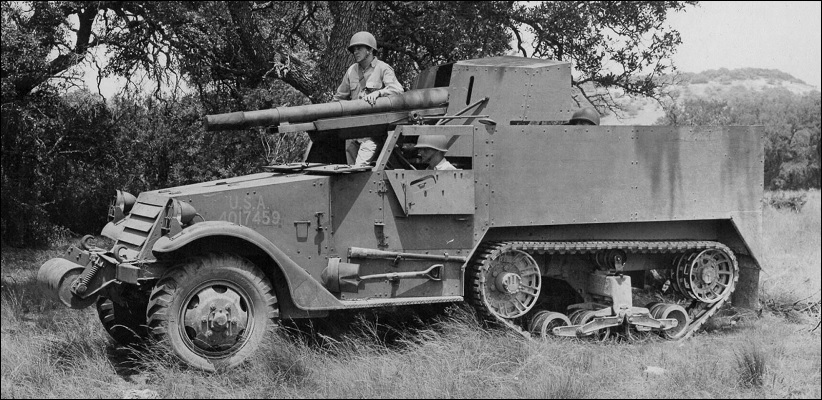
The M3
Tank Destroyer (75mm gun) saw action with
the US Army in the Philippines, North Africa
and Sicily (1941-43), and with the US Marine
Corps in the Pacific (1943-45).
(US Army Center
of Military History)
Though the Army envisioned an
ultimate force in excess of 200 TD battalions, only 106 were
actually activated during the war and for various
reasons—industrial priorities, shipping space—not all of
them could be SP units. So a heavy TD battalion (T),
organized similarly to the SP battalion but with the guns
towed by halftracks, was also specified. The AT gun was the
3in M5, which combined the barrel of the 3in antiaircraft
gun (AAG), already in service, with the suitably modified
breech, recoil mechanism and carriage of the 105mm M2
howitzer. For both
battalion types, overall manpower was cut from 900 to about
650 by eliminating the AAMG sections and streamlining the
headquarters company.
Development of a fully tracked tank destroyer to replace the
M3 had begun in 1940. Various designs were evaluated and
rejected before the T35E1 model was approved for production
as the M10 in June 1942. This tank destroyer was based on
the chassis of the M4A2 medium tank, with an open-topped
turret mounting the 3in M7 ATG—a modified M5—and a caliber
.50 heavy machine gun (HMG). Though bearing a superficial
resemblance to a tank, the M10 had much thinner armor and
was expected to rely for protection on speed and agility.
The M10 was destined to be the Army’s most numerous tank
destroyer of the war, with around 6,500 manufactured. Late
in the war it was supplemented by the M18 (76mm gun) and the
M36 (90mm gun).
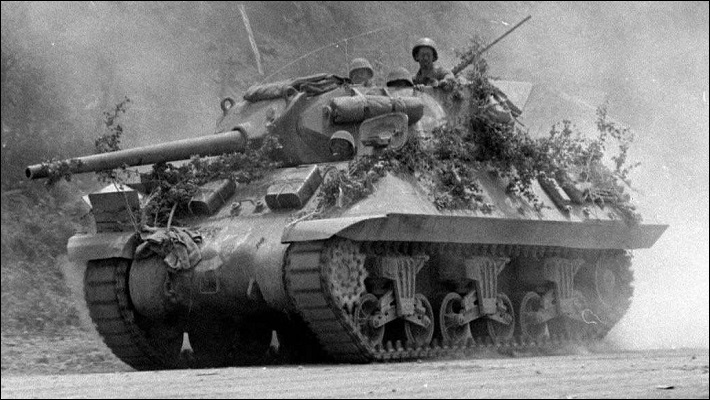
The M10 Tank
Destroyer (3in gun) was based on the chassis of
the M4A2 medium tank. Though it superficially
resembled that tank, the M10 had thinner armor,
higher speed and a more powerful main gun than
the M4A2. (Tank Encyclopedia)
Doctrine governing the employment
of tank destroyer forces was based on theoretical
conceptions of armored warfare, studies of the 1939-41
campaigns in Europe, and experience acquired in the Army’s
own field exercises. These led to the conclusion that a
static antitank defense would be inadequate in the face of
tanks attacking en mass.
What was required was
active defense in depth. This could of course be provided by
one’s own tanks, but then they would be unavailable for
offensive action. Instead, mobile tank destroyer forces
would do the job, deploying rapidly to contain any enemy
armored breakthrough by occupying key terrain behind the
front line, launching counterattacks and aggressively
opposing the enemy’s advance.
Such
tactics required a higher headquarters to coordinate the actions of the TD battalions: the tank destroyer
group, a brigade-level echelon capable of controlling up to
four TD battalions. The TD group was purely a tactical
headquarters, with no responsibility for logistical support
of its subordinate battalions. This group organization,
which was later extended to all Army branches except the
Infantry, was intended to provide the flexibility necessary
to carry out the TD mission.
The Tank Destroyer Force had its baptism of fire in North
Africa—with mixed results. The problem was not due primarily
to poor leadership and training—though instances of such
deficiencies were noted—but to faulty doctrine. The concept
of aggressive defense in depth proved problematical in
opposition to the German Army’s tactics, which were based on
the combined-arms Kampfgruppe
(battle group). Rather than charging forward en
masse, the panzers
operated in close cooperation with infantry and artillery,
always covered by a screen of mobile antitank guns. Thus the
US tank destroyers, with their thin armor, were severely
disadvantaged. In only one instance were they able to fight
as they had trained. The 601st TD Battalion, an SP unit
equipped with the M3 and reinforced by a company of the
899th TD Battalion with M10s, turned back an attack by some
fifty tanks of the 10th Panzer Division at El Guettar
(Tunisia). Employing fire and movement, the US tank
destroyers accounted for some thirty panzers but the price
was high: 20 of 28 M3s plus seven M10s were knocked out.
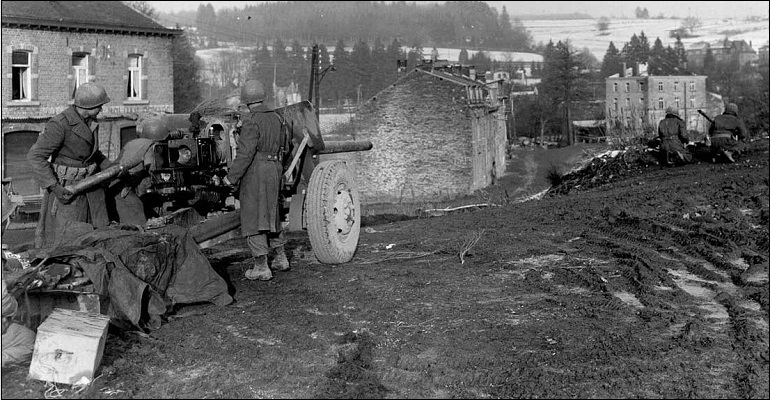
An M5 antitank
gun being prepared for action. The weapon itself
was effective, but towed guns proved vulnerable
due to their relatively low mobility compared
with self-propelled tank destroyers.
(US Army Center
of Military History)
More
typically, the tank destroyers operated in close support of
the infantry, usually being allotted by companies and
platoons to infantry battalions and companies. Perforce,
they developed methods of cover, concealment and combat that
prewar doctrine had never anticipated. Instead of operating
independently, tank destroyers reinforced the infantry’s
antitank defenses. Instead of fighting on the move, they
were sited in carefully chosen, well-camouflaged firing
positions. In this role they proved useful but such
attachments caused considerable logistical and command
problems, such that senior commanders’ dissatisfaction with
the whole tank destroyer concept grew steadily as the
Tunisian campaign wore on. And in fact, there would never be
an opportunity for the tank destroyers to operate in their
originally conceived role. The large-scale armored clashes
of the early years of the war and on the Eastern Front were
not repeated in Sicily, Italy or Northwest Europe, where the
Germans fought largely on the defensive. Thus by 1944 tank
destroyer battalions found themselves attached more or less
permanently to infantry and armored divisions. In most cases
they remained administratively subordinate to their TD group
HQ, but these no longer exercised tactical control. TD group
HQs deemed surplus to requirements were either dissolved or
used to form a third, reserve combat command HQ for armored
divisions (CCR).
Fortunately, as the Tunisian campaign had shown there were
other viable missions for the tank destroyers. The US infantry
division’s organic antitank assets were minimal: 21 x 57mm ATG, three in the divisional headquarters company and
eighteen in the regimental AT companies. The attachment of a
TD battalion was, therefore, a welcome reinforcement. SP
tank destroyers also served as assault guns in close support
of the infantry. With their high-velocity main armament they
were effective bunker busters, though their thin armor and
open-topped turrets made
them more vulnerable than tanks. They were also employed as
regular artillery firing high-explosive ammunition, the
necessary techniques having been developed during the
Tunisian campaign.
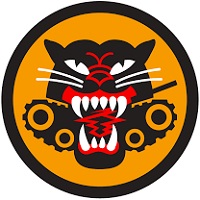
Shoulder Sleeve Insignia
of the Tank Destroyer Force 1941-46. (US Army Institute of
Heraldry)
TD
battalions were heavily engaged during the Battle of the
Bulge (December 1944-January 1945)—with mixed results.
Though the self-propelled tank destroyers performed well,
the towed units fared poorly. Guns towed by wheeled prime
movers proved insufficiently mobile to cope with the
Germans’ armored battle groups: Once emplaced they had to
fight it out where they stood, and all too often companies
or whole battalions were overrun. The Army therefore decided
to convert the remaining towed battalions to SP. A few TD
battalions, mostly equipped with the M10, served in the
Pacific. Since Japanese armored forces were minimal, the
tank destroyers served as assault guns.
The end
of the war heralded the end of the Tank Destroyer Force.
The late-war introduction of the M26 Pershing heavy tank, armed with
a 90mm gun, scotched the argument that tank destroyers
provided greater firepower that tanks. A postwar review
concluded that the tank destroyers, though useful, had
performed no mission that could not be performed by tanks. So the TD
battalions were quickly inactivated (though some were to
reappear later as tank battalions) and the Tank Destroyer
Center was closed down in 1946. Such was the unceremonious
demise of an Army branch that whatever its shortcomings had
played a significant and gallant role on the battlefield,
from North Africa to the Elbe River.
